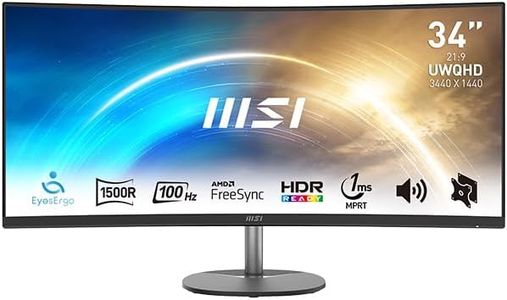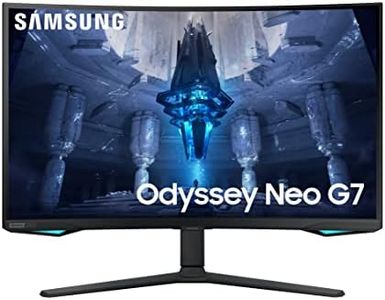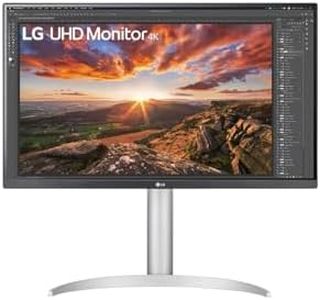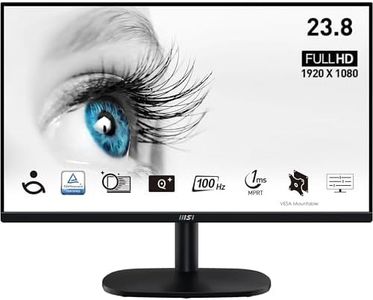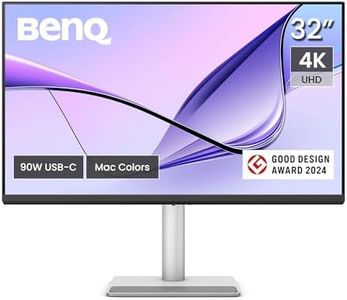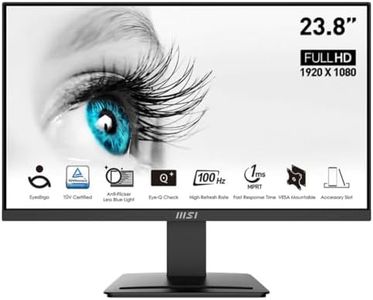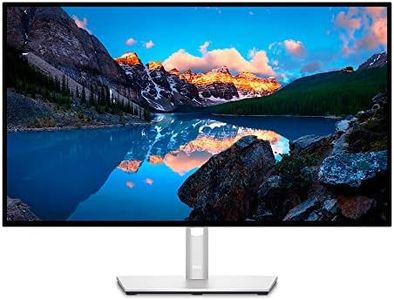We Use CookiesWe use cookies to enhance the security, performance,
functionality and for analytical and promotional activities. By continuing to browse this site you
are agreeing to our privacy policy
10 Best Computer Monitors
From leading brands and best sellers available on the web.Buying Guide for the Best Computer Monitors
Choosing the right computer monitor is essential for creating a comfortable and productive workspace, whether you are working, gaming, or enjoying movies. The right monitor can reduce eye strain, improve your experience, and match your needs regarding size, image quality, and connectivity. Before buying, consider how you'll use the monitor most (office tasks, design, gaming, entertainment, etc.) and think about how much physical space you have on your desk.Screen SizeScreen size is measured diagonally across the display in inches and influences how much content you can view at once. A larger screen gives you more real estate for multitasking or immersive viewing, but it also requires more desk space. Monitors typically range from around 21 to 32 inches. Smaller monitors (21-24 inches) are ideal for basic office work or small spaces, medium sizes (25-27 inches) are great for most uses and balanced setups, while larger screens (28 inches and up) are best for gaming, design, or multitasking with many windows. Match the size to your available space and typical use.
ResolutionResolution describes how many pixels the display has, affecting how sharp and detailed images and text appear. Common resolutions include Full HD (1920x1080), Quad HD (2560x1440), and 4K (3840x2160). Full HD is suitable for basic tasks and general use, Quad HD offers a clearer and crisper look for design or gaming, and 4K provides extremely sharp visuals for creative work or high-end entertainment. Choose higher resolution if you do design, video editing, or want sharper image quality, especially on larger screens.
Refresh RateThe refresh rate, measured in hertz (Hz), tells you how many times per second the image on your screen is updated. Standard monitors have a refresh rate of 60Hz, ideal for general office work and browsing. Higher refresh rates, like 75Hz, 120Hz, or 144Hz, make motion look smoother, which is important for gamers or people watching a lot of fast-moving video. If you mainly work or surf the web, 60Hz is fine, but gamers should look for higher rates to enjoy smoother gameplay.
Panel TypePanel type affects the display’s color quality, viewing angles, and response time. The main types are TN (Twisted Nematic), IPS (In-Plane Switching), and VA (Vertical Alignment). TN panels are fast and good for gaming, but have limited color and viewing angles. IPS panels have the best color and wide viewing angles, making them excellent for photo editing or sharing your screen. VA panels offer strong contrast and good color, suitable for watching videos. Pick IPS for color-critical work, TN for gaming speed, and VA for general use and media.
Ports and ConnectivityMonitors connect to your computer using different ports such as HDMI, DisplayPort, USB-C, or older ones like VGA. The types of ports determine compatibility and sometimes affect display quality. HDMI and DisplayPort are modern and support higher resolutions and refresh rates, while USB-C lets you connect and even charge laptops with just one cable. When choosing a monitor, make sure it has the ports your computer supports, and consider extra USB ports if you want to plug in accessories easily.
Ergonomics and AdjustabilityErgonomics covers how you can physically adjust the monitor, such as tilting, swiveling, height adjustment, and pivoting between landscape and portrait. Good ergonomics let you set a comfortable viewing angle, which can reduce neck and eye strain over long periods. If you spend hours at your desk, look for a monitor with plenty of adjustability or at least VESA mount compatibility, which lets you use a custom monitor arm.
Special FeaturesSome monitors come with extras like built-in speakers, blue light filters to reduce eye fatigue, or adaptive sync technologies (like FreeSync or G-Sync) to prevent screen tearing during gaming. Decide if these features are important for your use; for example, built-in speakers are helpful if you don’t want external ones, and blue light filters are good if you work at night.

